Published for INSPADES Magazine, Issue Due, December 2016
We live in the confines of mortality within the sphere of a declining planet. While the earth can no longer support our excessive consumption, skeptics still wonder if climate change is real, and if it is, how can artistic eco-activism make a difference?
Art and Communication
According to Ryerson Image Centre director Paul Roth, art opens the most effective channel for change; “It allows the conversation to take place.” With its exhibition, Edge of the Earth: Climate Change in Photography and Video, Toronto’s RIC has set out to prove that art can, in fact, ignite shifts in ideology.
Curated by Dr. Bénédicte Ramade, the exhibition gathers visual chapters from different artists who focus on niche effects of climate change, collectively contributing to the “larger story” of the planet’s tumultuous narrative. Rather than portraying the consequences of climate change that we experience today, Edge of the Earth provides context for how our daily habits and industrial practices add to the damage.
 The exhibition opens with the work of Naoya Hatakeyama, whose photography recorded blast impacts from limestone mining operations. “The pictures are not of climate change or a changing environment,” Roth explained, “They’re pictures of the industrial operations that led to the environmental crisis that we face now.”
The exhibition opens with the work of Naoya Hatakeyama, whose photography recorded blast impacts from limestone mining operations. “The pictures are not of climate change or a changing environment,” Roth explained, “They’re pictures of the industrial operations that led to the environmental crisis that we face now.”
 Roth goes on to present Joel Sternfeld’s jarring photography, which bore witness to the reaction of attendees in the 2005 United Nations Climate Change conference in Montreal. Sternfeld “photographed the reaction of people at the conference listening to the increasingly terrible news about the projections of our future,” Roth elaborated, “They were the first to hear the bad news, and the pressure that they’re feeling in these images is the pressure that we increasingly feel as we encounter climate change in our daily lives.” Inadvertently Sternfeld’s portraits are in fact pictures of us, Roth observed.
Roth goes on to present Joel Sternfeld’s jarring photography, which bore witness to the reaction of attendees in the 2005 United Nations Climate Change conference in Montreal. Sternfeld “photographed the reaction of people at the conference listening to the increasingly terrible news about the projections of our future,” Roth elaborated, “They were the first to hear the bad news, and the pressure that they’re feeling in these images is the pressure that we increasingly feel as we encounter climate change in our daily lives.” Inadvertently Sternfeld’s portraits are in fact pictures of us, Roth observed.
“When we show photographs about social subjects or political topics, we always wonder, will this change anyone’s mind? Will people be driven by what they see to actually go out, protest, contact legislatures, or do any of the other forms of political engagement that actually make change?”
Roth voices the great question of how art can make an impact, beyond the momentarily charged response of a viewer. In a world where attention is spread thin by infinite distractions and stimuli, visual art may be a more relevant medium for sparking change than ever.
“People are not necessarily reading very difficult news articles about the future,” Roth remarked; however, with an image-based society that appeals to communicative outlets like Instagram and Snapchat, visual arts can impress viewers within seconds.
“Art is one of the ways that a subject can be insinuated to the public mind, in a way that’s less threatening and receptive to different points of view,” Roth asserted. An example of this would be the works of American photographer Chris Jordan, who’s collection of polluted seabirds elicited the most significant response from viewers at the exhibition.
 Traveling the shorelines of beaches and islands around the world, Jordan photographed the content of seabirds’ stomachs, burst open and bare as they decayed on the sand. “What you see is horrifying,” Roth lamented, “You see that the diet of these seabirds increasingly consists of plastic and other human waste.”
Traveling the shorelines of beaches and islands around the world, Jordan photographed the content of seabirds’ stomachs, burst open and bare as they decayed on the sand. “What you see is horrifying,” Roth lamented, “You see that the diet of these seabirds increasingly consists of plastic and other human waste.”
While speculations from skeptics claim that Jordan’s photographs are “ersatz documentary images”—images that are staged but mimic something real—Roth insisted that the message prevailed regardless of the image’s nature.
“These pictures, even if they are not documentary images, have had a tremendous impact because they make our viewers ask the question, could this possibly be real and are we really having this kind of an impact on wildlife and on the natural world?”
At the end of the day, Roth argues that art certainly has a place in any social or politically charged movement. Art is a less-confrontational means for communication, making it “incredibly easy to connect people who otherwise might not see eye to eye on a certain subject, or share a perspective about different experiences.”
This Planet Is Not A Carefree World
Another artist striving to inspire change in the discourse around social issues and the environment is American animator Jeff Hong. “There’s a natural tendency to give a different perspective to something familiar, and turn it upside down,” Hong said of his series, Unhappily Ever After, which removes Walt Disney characters from their fantasy realms and places them in stark, realistic settings.
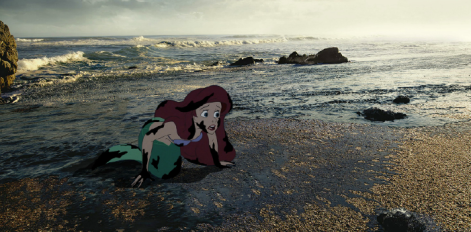 Having worked on a handful of renown Disney films including Tarzan, Hercules, Mulan and The Emperor’s New Groove, Hong decided to harness the emotional connection and nostalgia that audiences have for such beloved Disney characters. “I wanted to show the consequences of what would happen if we transported them away from their magical fairytale land and into the world we live in,” he explained. By displacing these characters, both human and animal, Hong splits the theatrical curtain: “Not one living thing on this planet lives in a safe, carefree world.”
Having worked on a handful of renown Disney films including Tarzan, Hercules, Mulan and The Emperor’s New Groove, Hong decided to harness the emotional connection and nostalgia that audiences have for such beloved Disney characters. “I wanted to show the consequences of what would happen if we transported them away from their magical fairytale land and into the world we live in,” he explained. By displacing these characters, both human and animal, Hong splits the theatrical curtain: “Not one living thing on this planet lives in a safe, carefree world.”
Ariel, the favourite finned princess of The Little Mermaid, wriggles ashore in “Oil Spill”, crippled and smothered by the toxic spread on her body. In another image, the famous Elsa from Disney’s recent hit, Frozen, weeps on a drifting glacier amid the expanse of a melting arctic landscape. Again Hong tears a character from their idealistic setting by placing Winnie the Pooh in a ravaged forest. In “The Hundred Acre Deforestation,” Pooh scratches his head in confusion as he sits among the wreckage of wood chips.
“Creating an emotional response through images can be effective for eco-activism,” said Hong, “if not to change people’s opinions, then to remind ourselves of the daily things we do that affect the environment.”
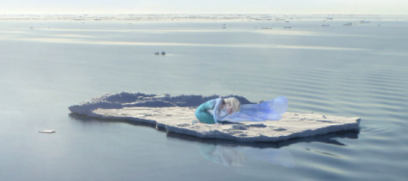 While he believes that it’s too late to stop the damage we’ve incurred on the planet, Hong maintains that we can still “slow the damage down.” Hong’s works aim to disturb complacency and remind viewers that “our choices can have a large affect on others.” The cunning paradox of Unhappily Ever After is that, while living “(un)happily” ever after suggests a fated ending that cannot be changed, Unhappily Ever After also portrays the characters’ endings as the result of our actions, rather than destiny.
While he believes that it’s too late to stop the damage we’ve incurred on the planet, Hong maintains that we can still “slow the damage down.” Hong’s works aim to disturb complacency and remind viewers that “our choices can have a large affect on others.” The cunning paradox of Unhappily Ever After is that, while living “(un)happily” ever after suggests a fated ending that cannot be changed, Unhappily Ever After also portrays the characters’ endings as the result of our actions, rather than destiny.
“Unhappily Ever After gives a false impression that we can’t do anything to better ourselves or the environment,” said Hong. While the effects of climate change can’t be reversed, the rate at which the climate changes can be decelerated, as our actions and choices can contribute to the resulting effect.
Hong’s repurposed Disney characters motivate viewers to live more consciously by fighting anti-environmental policies, reducing our consumption rates and “replenishing what we use.”
“To me, making the viewer pause and really think is the strongest and most effective way I can engage an audience without using any words.”
Keep Your Oil Out of My Water
The work of ecologist artist Dr. Aviva Rahmani could not be more relevant than today where, in the United States especially, issues related to oil and water been making global headlines lately.
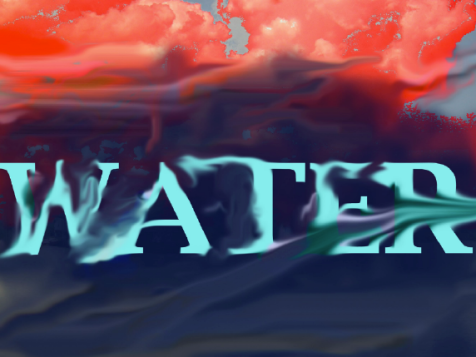 Most notably is Donald Trump’s recent rise to the president-elect. One of Trump’s election platforms threatened to dismantle the recent Clean Power Plan, which aims to reduce carbon pollution in American power plants. Carbon dioxide (which accounted for 81% of the United States’ greenhouse gas emissions in 2014), enters the atmosphere when fossil fuels like natural gas and oil are burned. Whether or not Trump manages to uproot the Clean Power Plan once seated in the White House, the stance he has taken does not consider issues relating to climate change to be a priority, especially regarding sustainable energy and the reduction of oil use.
Most notably is Donald Trump’s recent rise to the president-elect. One of Trump’s election platforms threatened to dismantle the recent Clean Power Plan, which aims to reduce carbon pollution in American power plants. Carbon dioxide (which accounted for 81% of the United States’ greenhouse gas emissions in 2014), enters the atmosphere when fossil fuels like natural gas and oil are burned. Whether or not Trump manages to uproot the Clean Power Plan once seated in the White House, the stance he has taken does not consider issues relating to climate change to be a priority, especially regarding sustainable energy and the reduction of oil use.
When Dr. Rahmani spoke with INSPADES prior to the 2016 election results in October, she expressed concern that the “chasm that has been unveiled in [American] demographics will gobble up all our attention,” and that climate change initiatives would fall to the back burner.
Despite the distraction of Trump’s controversial triumph, headlines have been drawing the environmental issues concerning Standing Rock Reservation into mainstream discourse. Even celebrities like Jason Momoa, Khal Drogo in Game of Thrones, are using social media to raise supportive awareness and show their solidarity with the people of Standing Rock.
Since April this year, the residents of Standing Rock have been blocking the Dakota Access Pipeline with their campsites in heated opposition to construction. They have since risen in strength, with over ninety indigenous groups across North America joining their protest. The Dakota Access pipeline, which would carry crude oil under the Missouri River reservoir, threatens the community’s main water source and cultural sites.
While the majority of people do associate the term “oil spill” with negativity, they don’t always grasp the toxic ripple effect of such disasters. By visually representing contamination in her series Oil & Water, Dr. Rahmani hoped to “connect the idea that oil spills degrade water systems.”
With her artwork Dr. Rahmani captured the “deceptively beautiful sheen” of contaminated water, conveying the irony of how attractive “life subsidized by the agony of the entire planet” can seem on a surface level. “I wanted to make something that would illustrate exactly how water is befouled,” she explained.
In 2008, Dr. Rahmani journeyed by train down the continent, “passing fields of corn for ethanol shared with fields for cows.” The jarring juxtaposition of crops being harvested for fuel on the same land where cows (harvested for human consumption) were feeding, created a visual of toxicity, representing the negative impact of our lifestyles on the planet. Traveling to a conference in Baton Rouge, Dr. Rahmani met Dr. Eugene Turner, a wetland biologist, whom she later joined in efforts to produce Gulf to Gulf, an endeavor to effect climate change policy with art.
Through various artistic mediums, Gulf to Gulf recorded the cyclical catastrophe of oil, “the destructive loop between fertilizers derived as by-products from oil, applied to factory farms, running into the Mississippi and making dead zones in the Gulf, where ever more oil is extracted and spilled in what was once one of the world’s richest ecosystems.”
While Gulf to Gulf continued to grow as a project in 2009, the Oil & Water series came into being with a simplified visual message and a potent strike at the heart of the issue. “We are in a war for our very survival,” Dr. Rahmani claimed. It is her hope that politically charged series like Oil & Water will enable widespread recognition of “the threat portrayed in the image,” and that people would be “mobilized to action.” Oil & Water engages conversation, as each image offers hope in the form of “a meditative mandala for ecological enlightenment.”
Trash Talk and Sustainable Creativity
Let’s talk dirty. Resourceful artists Marina DeBris and Aurora Robson have turned discarded trash into artistic treasure, repurposing waste in an effort to rejoin the circle of sustainability and recycling.
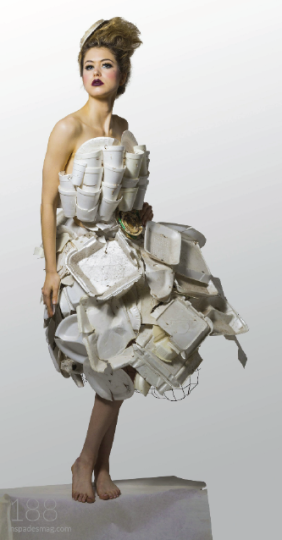 It’s easy for consumers to toss their excess product in the bin and never be faced with its accumulation. In 2013, statistics by Eurostat found that in the European Union each individual generated an outrageous amount of packaging waste – roughly 157 kgs (346 lbs.). The consumptive mentality of society has become far too aggressive, with increasing demands for more product than can be produced by a limited planet.
It’s easy for consumers to toss their excess product in the bin and never be faced with its accumulation. In 2013, statistics by Eurostat found that in the European Union each individual generated an outrageous amount of packaging waste – roughly 157 kgs (346 lbs.). The consumptive mentality of society has become far too aggressive, with increasing demands for more product than can be produced by a limited planet.
“When I moved to Los Angeles, I was appalled at the amount of rubbish washing up on the beaches,” said DeBris, whose name is an intentional play on “debris”. After moving to Australia, she realized that polluted beaches were a “worldwide problem.” DeBris and Robson remind viewers that waste, such as plastic, can never be broken down naturally; however, it can be sublimated.
Converging trash and fashion, DeBris created the innovative and sustainable art of “trashion”, incorporating waste into high-end clothing designs to impress the possibilities of reusability. “It’s really quite simple,” DeBris told INSPADES while explaining the message behind her work, “We need to drastically reduce the amount of single-use plastic we consume.”
Designing elaborate gowns from Styrofoam food containers and corsets from plastic cutlery and straws, DeBris’ trashion is surprisingly edgy, taking the “Paper Bag Princess” image to a whole new level.
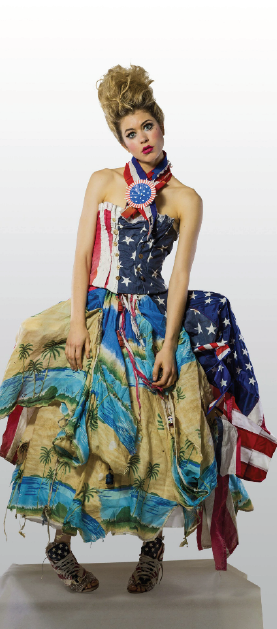 “I was trained as a graphic designer, so getting my hands dirty has been tremendously liberating,” shared DeBris, who went on to explain that the garbage she gleans from shorelines have been in the ocean for so long, that wearing the items is “no worse than swimming in the sea.” “Some people are disturbed to know that I don’t clean anything,” she mused, “but making the trash look beautiful would dilute the message.”
“I was trained as a graphic designer, so getting my hands dirty has been tremendously liberating,” shared DeBris, who went on to explain that the garbage she gleans from shorelines have been in the ocean for so long, that wearing the items is “no worse than swimming in the sea.” “Some people are disturbed to know that I don’t clean anything,” she mused, “but making the trash look beautiful would dilute the message.”
In a separate interview with INSPADES, inventive multi-media artist Aurora Robson agreed with DeBris’ appropriation of trash. Based in New York, Robson has inserted herself into the waste stream cycle by bringing her enchanting artistry to the mix.
“Waste is merely displaced abundance,” she expressed.
“I hope that when people see my work, they think about their relationship to matter of all kinds,” said Robson, who works mostly with plastic due to its overproduction and detrimental impact on the environment.
“Debris is typically, by definition chaotic, dirty, crumpled, dystopian, inconsistent and clearly unintentional. I try to give it the opposite qualities,” explained Robson, whose ventures in intercepting the waste stream first began with an attempt to subjugate negativity.
“My work started off as a quiet, personal meditative practice. I stumbled upon the issue of plastic pollution and the problems associated with this increasingly pervasive material.”
 In her installation “Plant Perception”, Robson commanded the shape and appearance of trashed materials, creating alien movement from garbage to form a lively, crystalline sculpture. “This problematic condition, our collective addiction to newness, keeps me engaged with product design and makes my practice more interesting and challenging to me,” said Robson, whose work finds a place for each piece of discarded waste that we so carelessly toss on the regular.
In her installation “Plant Perception”, Robson commanded the shape and appearance of trashed materials, creating alien movement from garbage to form a lively, crystalline sculpture. “This problematic condition, our collective addiction to newness, keeps me engaged with product design and makes my practice more interesting and challenging to me,” said Robson, whose work finds a place for each piece of discarded waste that we so carelessly toss on the regular.
Many of Robson’s sculptures, such as “Isla” and “Ona”, resemble stained glasswork with their translucent vibrancy and voluptuous movement. Created from plastic waste alone, Robson repurposes the negativity of garbage for decorative and meaningful communication.
“The universe consists of spheres,” Robson explained of her curvaceous pieces, “I am constantly trying to imagine ways to reflect that in my work—the circularity of existence. The wholeness we are all part of.”
Moving beyond the art of sustainable creativity, Robson founded Project Vortex, a collective for artists working with waste. The community unites the voices of artists and confronts the issue of waste through a unique approach. Project Vortex serves to “form more ties between conservation efforts and artists around the world,” who are working together to rewire society’s obsession with single-use plastic.
When Robson began her work and launched the Project Vortex network, she didn’t approach waste issues with a political agenda. “I really just try to make work that transcends issues that are divisive,” said Robson, who hoped to bring people together through her work, instead of forcing them apart by revealing their differences.
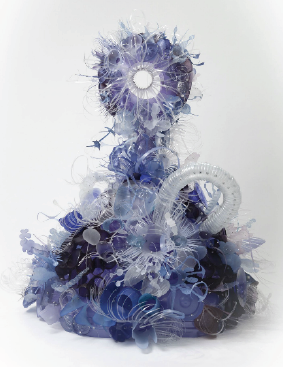 “I think real changes will take place through education,” Robson explained, delving into her reason for designing the educational course, “Sculpture + Intercepting the Waste Stream”. According to Robson, the college course guides students in their discovery of waste conversion to art, allowing “creative stewardship to emerge with generations of young people who will do a far better job at protecting our environment than their predecessors.”
“I think real changes will take place through education,” Robson explained, delving into her reason for designing the educational course, “Sculpture + Intercepting the Waste Stream”. According to Robson, the college course guides students in their discovery of waste conversion to art, allowing “creative stewardship to emerge with generations of young people who will do a far better job at protecting our environment than their predecessors.”
While Robson admitted to feeling “disheartened” and “powerless” in the face of monumental waste and the incessant damage we inflict on our planet, she believes that pairing art and science within the realm of education will inspire “effective agents for change.”
The world of diverse creative expression has the power to take root in human impressions, regardless of whether or not the artwork is intentionally politically charged. By simply suggesting the concept of reusability and mindful consumption, the visually communicative medium can host a platform for discussion, which is the first step in progress.
“We need to refresh our collective memories on how to behave as a species,” concluded Robson, “without adversely affecting our environment.”
